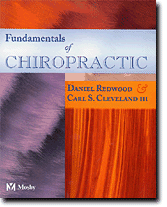|
|
Fundamentals of Chiropractic
Book Review by Steven Lavitan, DC, LAc
| Title: |
Fundamentals of Chiropractic |
| Author: |
Daniel Redwood, DC, and Carl S. Cleveland III, DC |
| Publisher: |
Mosby, 2003 |
| Type: |
Softcover,
700 pages |
| Price: |
$54.95 |
| Part
#: |
T-500 |
 Drs. Daniel Redwood and Carl Cleveland III have edited the most thorough anthology on chiropractic to date. Each chapter's author is an authority in his or her own way, and the aggregate provide a wonderful panorama of chiropractic. If this book - 30 chapters and 700 pages - truly is the fundamentals of chiropractic, the advanced version must be the size of an encyclopedia. Drs. Daniel Redwood and Carl Cleveland III have edited the most thorough anthology on chiropractic to date. Each chapter's author is an authority in his or her own way, and the aggregate provide a wonderful panorama of chiropractic. If this book - 30 chapters and 700 pages - truly is the fundamentals of chiropractic, the advanced version must be the size of an encyclopedia.
Thirty years ago, Dr. Joseph Janse started my orientation at the National College of Chiropractic with Victor's Hugo's quote, "Nothing is more powerful than an idea whose time has arrived." After reading this book, I realize that time may be now.
The following are a series of highlights from Fundamentals of Chiropractic:
- All chiropractors use respiration in some form to effect an adjustment,
but eye motion can also help. Eye movements, coordinated in the direction
the head moves, allow spinal muscle to relax, facilitating gentler, easier
adjustments.
- A retrospective study on maintenance care (a minimum of four visits
per year for five years) of patients older than age 65 revealed average annual
health
care expenditures of $3,106, versus $10,041 for other seniors.
- Peripheral nerve root entrapment is far more common than spinal nerve
root entrapment. Probably the most common is a traction neurodesis caused
by
fibrosis tissue losing its gliding function. Some of these nerve excursions
are considerable,
often in multiples of centimeters.
- Internal validity is the degree to which the results of a study are
correct. A study without internal validity is meaningless. External validity
is
the degree to which a study holds true in settings other than the study
setting. The Mead study is the classic external validity study because it
allowed
the British chiropractors and the physical therapists to do their normal
procedures;
it just judged the results. Unfortunately, this leaves it open to
the criticism that the greater attention and rapport chiropractors give may
account
for
the
difference.
- Visceral research discusses respiration as a visceral function that
depends on the skeletal system to make inspiration and expiration possible.
Even
if a connection between chiropractic and lung tissue is never made,
the improvement of the muscle tone is a worthwhile goal. Improvement in lung
capacity has
untold
implications, not the least of which is that decreased lung capacity
is a marker of aging.
- A cervical adjustment has the attendant risk, actuarially speaking,
of 1.1 miles driven. In other words, a patient driving 2.2 miles to
your office has twice the odds of being injured during the trip than while
getting
his
or her
neck corrected.
- According to Dr. McAndrews, the Mercy Guidelines were an important
ingredient
for the AHCPR recommendations being as positive as they were
toward chiropractic.
For the serious student of chiropractic, Fundamentals of Chiropractic is
a 10. In this reviewer's opinion, this may be the most important book on
chiropractic published in the past decade.
Dr. Lavitan's
rating:
 10 out
of 10 10 out
of 10

Post your thoughts in our discussion forum
|

|








